"Though we have achieved progress, our work is not over. That is why I support the mission of the Arms Control Association. It is, quite simply, the most effective and important organization working in the field today."
December 2024
By Jenny Town
There is great anxiety among U.S. allies and partners about how U.S. President-elect Donald Trump’s second administration will approach alliance management. The potential return to transactional relations raises questions about what new price will be placed on continued partnership and whether countries should pay it. South Korea, in particular, felt the brunt of this treatment during Trump’s first term and is bracing for whatever new demands may come next.
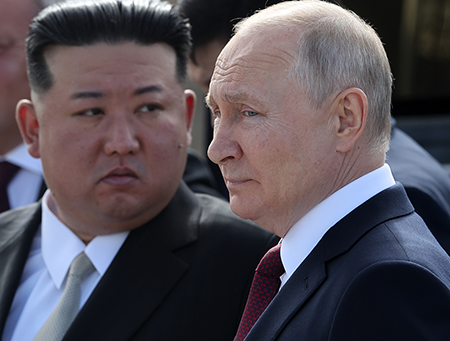
Trump already has taken note of the fact that the South Korean-U.S. Special Measures Agreement, which determines the cost sharing of maintaining U.S. troops on the Korean peninsula, was renegotiated early, presumably to avoid the kind of inflationary pressures that were likely under Trump. The new agreement, concluded in October, raises South Korea’s cost commitment by 8.3 percent to $1.47 billion for 2026.1 The announcement drew criticism from then-candidate Trump, who claimed, “If I were there [in the White House] now, they would be paying us $10 billion a year,” and asserted that the South Koreans “would be happy to do it. It’s a money machine, South Korea.”2
This reaction has concerned many South Korean officials who worry that Trump will push to renegotiate the agreement after he takes office. Whether he will have advisers around him who are willing to curb this impulse is unclear. If not, how South Korean President Yoon Suk Yeol responds to such pressures will set the tone for relations going forward.
If South Korea is forced to renegotiate the agreement, it likely will comply and raise contributions further to some degree, but demand a trade-off in return. The most likely trade-off would be a South Korean demand to renegotiate the South Korean-U.S. nuclear cooperation agreement to grant Seoul enrichment and reprocessing rights.
South Korea has sought this approval for decades for its nuclear energy industry to improve its self-sufficiency and competitiveness and to help manage the industry’s growing spent fuel storage challenge. Although this ambition is largely for peaceful nuclear energy purposes, the intensifying debate in Seoul over whether the country should develop its own nuclear weapons raises serious questions about its intentions toward enrichment and reprocessing activities and undermines its otherwise notable commitment to nonproliferation.
On the North Korea front, Trump is likely to defer direct action in the near term. Ending the war in Ukraine appears to be more of a top priority for him, along with setting the tone for Chinese-U.S. relations. Yet, both of these efforts could have an indirect impact on North Korea, especially its increasingly close relationship with Russia. For instance, conditions about Russia’s relations with North Korea may well be included in any negotiation on Ukraine, thus testing how deeply Russian President Vladimir Putin is invested in keeping North Korea close.
Arguably, Putin would find it more difficult to abandon Pyongyang now that North Korean lives are being sacrificed on Moscow’s behalf. Should an agreement on Ukraine sever, for instance, even just North Korean-Russian military cooperation, this would be well received in South Korea, easing some anxiety over Russia’s potential assistance in improving or advancing Pyongyang’s weapons of mass destruction capabilities. Yet, North Korean leader Kim Jong Un is not likely to take this well after being a loyal partner to Putin throughout his illegal war and signing into law the treaty to codify their partnership, including in the military sphere.
While trying to set a new Chinese-U.S. agenda, Trump may also try to lean on Chinese President Xi Jinping to help moderate North Korea’s behavior, as the U.S. leader did early in his first term. This time, however, such an effort likely would be in vain. Beijing’s influence over Pyongyang has been greatly diminished in recent years as Moscow’s has risen. A change in North Korean-Russian relations could alter that dynamic, but not overnight and probably not to the degree it would take for China to become a credible broker.
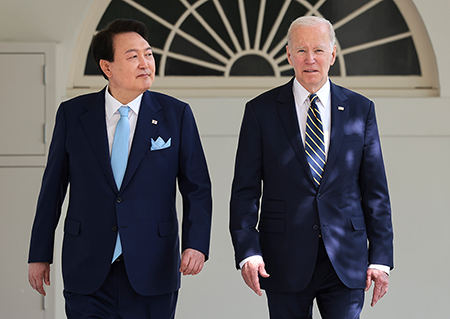
More importantly, Xi has been burned by Trump on this issue. In 2017, Xi agreed to help Trump with North Korea in exchange for not being labeled a currency manipulator and avoiding a trade war with the United States. China did more that year under the maximum pressure campaign than ever before, but despite these efforts, Trump began to gradually impose a series of new tariffs on Chinese imports in 2018 and 2019, triggering retaliatory tariffs from China; and in August 2019, the U.S. Department of the Treasury designated China a currency manipulator.3 Whatever room there may be for Chinese-U.S. cooperation in the current geopolitical environment, North Korea is not the “easy place” to start.
In the meantime, although Trump may think he has time to defer dealing directly with North Korea until he is ready, Kim may not afford him that luxury. Already, North Korea has called for the “limitless” expansion of its nuclear program.4 Earlier this year, it revealed a large uranium-enrichment facility, underscoring its ability to ramp up nuclear weapons production, and flight-tested a new, larger intercontinental ballistic missile.5
So far, presumably for political reasons, North Korea has refrained from additional nuclear weapons testing, despite having at least one untested warhead design. That restraint certainly could be lifted if Kim feels betrayed by his current closest ally to demonstrate his willingness and ability to carry on without outside support. Further progress on reconnaissance satellites, multiple warheads, and reentry vehicle technologies also are expected.
North Korea also could turn more inward to accelerate plans already in motion. Kim has renounced peaceful unification, designated South Korea a hostile state, and severed inter-Korean transportation infrastructure and is working to make permanent North Korea’s sovereignty. Recent references to fortifying the “southern border” suggests further changes are coming that are likely to challenge the legacies of the Korean War, such as the persistence of the Demilitarized Zone itself.6
Questions about whether aspects of the 1950-1953 Korean War Armistice Agreement, such as the continuation of the Demilitarized Zone versus a transition to more normal border management protocols, should be up for piecemeal renegotiation outside of a formal peace treaty process and are likely to come up sooner rather than later. Seoul is unlikely to be willing to negotiate on such matters, but Trump may not dismiss the proposition so easily. Disagreement on how to respond to such a challenge may cause a major rift in South Korean-U.S. relations and renew calls in South Korea for its own nuclear armament.
Under normal circumstances, North Korea’s risk tolerance for taking actions that provoke South Korea and the United States has been consistently higher than what either Seoul or Washington could conceive of doing in return. Even during the “fire and fury” days of the first Trump administration, there was a lot of a fury, but no fire.7 Will that remain true?
Trump seems to believe he has a good relationship with Kim already and that he can take his time.8 North Korea may test him early if only to underscore Kim’s strengthened position this time around. Whether Trump in his second term will be more or less risk tolerant on the Korean peninsula is still an open and worrisome question.
ENDNOTES
1. Young Gyo Kim, “Experts: Future of U.S.-South Korea Defense Cost-Sharing Deal Remains Uncertain,” Voice of America, October 11, 2024, https://www.voanews.com/a/experts-future-of-us-south-korea-defense-cost-sharing-deal-remains-uncertain-/7819599.html.
2. Julian Ryall, “South Korea Shocked by Trump’s ‘Money Machine’ Plan,” Deutsche Welle, October 22, 2024, https://www.dw.com/en/south-korea-shocked-by-trumps-money-machine-plan/a-70564833.
3. Inhan Kim, “Trump Power: Maximum Pressure and China’s Sanctions Enforcement Against North Korea,” The Pacific Review, Vol. 33, No. 1 (2020): 96-124; Danielle Paquette, David J. Lynch, and Emily Rauhala, “As Trump’s Trade War Starts, China Vows Retaliation,” The Washington Post, July 6, 2018; U.S. Department of the Treasury, “Treasury Designates China as a Currency Manipulator,” press release, August 5, 2019, https://home.treasury.gov/news/press-releases/sm751.
4. Kim Tong-Hyung, “North Korean Leader Calls for Expanding His Nuclear Forces in the Face of Alleged U.S. Threats,” Associated Press, November 17, 2024.
5. Olli Heinonen et al., “First Look at North Korea’s Uranium Enrichment Capabilities,” 38 North, September 13, 2024, https://www.38north.org/2024/09/first-look-at-north-koreas-uranium-enrichment-capabilities/; Vann H. Van Diepen, “North Korea Tests New Solid ICBM Probably Intended for MIRVs,” 38 North, November 5, 2024, https://www.38north.org/2024/11/north-korea-tests-new-solid-icbm-probably-intended-for-mirvs/.
6. “North Korea Vows to Block and Fortify Border With South,” Deutsche Welle, October 9, 2024, https://www.dw.com/en/north-korea-vows-to-block-and-fortify-border-with-south/a-70447450.
7. John Walcott, “Trump’s ‘Fire and Fury’ North Korea Remark Surprised Aides: Officials,” Reuters, August 9, 2017.
8. Simone McCarthy, “Trump Claims Kim Jong Un ‘Misses’ Him. But He Faces a Very Different North Korean Leader This Time Around,” CNN, November 8, 2024, https://www.cnn.com/2024/11/08/asia/trump-kim-jong-un-north-korea-intl-hnk/index.html.
Jenny Town is a senior fellow at the Stimson Center and the director of the center's Korea Program and 38 North publication.
December 2024
By Ellie Geranmayeh
When U.S. President-elect Donald Trump reenters the White House, he faces the most advanced Iranian nuclear program to date.1 Iran now has enough fissile material to produce three bombs within weeks. This proliferation threat exists within a Middle East that is on high alert, with Israel and Iran on the brink of wider conflict. These realities could drag U.S. forces into further military operations, just as the incoming president pledged to end the wars in this region.
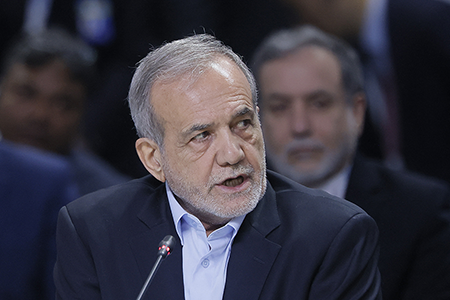
In his first term, Trump backed his hawkish advisers to pursue a “maximum pressure” policy aimed at throttling Iran’s economy. Trump was wrongly sold on the idea that this approach would bring Iran to its knees and result in a capitulation to U.S. demands at the negotiating table. Instead, Tehran expanded its nuclear program and ratcheted up attacks against U.S. forces.
Rather than making a deal with the United States, as Trump hoped, Iran is now increasingly aligned with and economically dependent on China and Russia. Despite U.S. efforts to isolate Iran in the region, the Arab monarchies in the Middle East have pursued rapprochement with Tehran. In short, maximum pressure badly backfired.
The Ball in Trump’s Court
Following the Gaza war and the sharp uptick in military confrontation between Israel and Iran since April 2023, Iran seems to have edged toward a new ultimatum for the incoming Trump administration. Either Trump is dragged into the simmering war between Israel and Iran, or he cuts a deal with Iran that creates a cold peace.
Since the U.S. election, Iranian officials have signaled openness to a direct political track with the Trump administration, warning that a return to a maximum-pressure 2.0 approach “will only result in ‘maximum defeat 2.0.’”2 Iranian Supreme Leader Ayatollah Ali Khamenei seems to have given the green light for the new government of President Masoud Pezeshkian to test new direct negotiations with Washington over the nuclear program. Although it is possible that Khamenei may eventually retrench or undermine this track, for now the ball is in Trump’s court.
During recent campaigning, Trump repeated his desire to cut a deal with Iran. The major unknown is what path he might choose to get to the negotiating table. Trump could choose to repeat the mistakes of his first term by allowing his hawkish foreign policy advisers to double down on maximum pressure policies.
A second, untested option: Trump can use the first 100 days of his administration to open a direct diplomatic channel to Tehran and begin a dealmaking process in ways that President Joe Biden was unable to do. The reported meeting following the U.S. elections between Elon Musk, a member of Trump’s inner circle, and Iran’s envoy to the United Nations could pave the way to advancing this track once Trump takes office.3 Such an opening by itself could help cool the conflict between Israel and Iran immediately and freeze the Iranian nuclear program.
Getting to a Political Process
To get to a political process once Trump is in office, Iran and Trump’s transition team should carefully consider and plan to quickly agree on three key points. First, the two sides need to decide on the format for talks. Iran and the United States usually have used intermediaries, such as European and Arab countries, or multilateral settings such as the P5+1 to negotiate.4 Given tensions between European countries and Russia over the war in Ukraine, that format can no longer be used for near-term talks regarding Iran. The possibility for direct Iranian-U.S. talks should not be ruled out, and Tehran increasingly is signaling that it sees the value in such a format.5
In his first term, Trump’s preference was also for a direct, high-level meeting with Iranian counterparts.6 Back then, this option was unacceptable to Iran, given Trump’s decision to withdraw from the 2015 nuclear accord. It will be even more difficult now for Tehran to accept a meeting with Trump at the onset of talks given his decision to order the assassination of Iranian General Qassem Soleimani in 2020.
Yet, given the latest messaging from Tehran and the meeting with Musk, Iran could be persuaded to advance negotiations with a high-ranking U.S. official and then to finalize the talks at the presidential level. A leader such as Saudi Arabian Crown Prince Mohammed bin Salman, who is close to Trump and is pursuing an important détente with Tehran, could push the two sides to undertake such talks.
Second, Iran and the United States need to decide the agenda and priorities for negotiations. The two sides are at odds over many topics, from nuclear proliferation, their respective military postures in the Middle East, human rights, and Iranian military support to Russia. A major question is whether Trump would seek to isolate Iran’s nuclear program as the highest threat to U.S. national security or take a grand bargain approach.
Neither approach is easy, nor will it lead to satisfactory results. Given the gravity of current tensions and past experience, however, Iran and the United States are unlikely to be able to negotiate a grand bargain. The two sides can unlock better progress by endorsing two parallel yet distinct tracks. The first track should focus on Iran’s nuclear program and entail trade-offs between Iran and the United States. The second track, which should be simultaneous, must intensify the ongoing regional deescalation negotiations with Iran led by Saudi Arabia. Both tracks should seek to bring Iran and Israel back from the brink of war, while acknowledging that the two countries will continue their shadow conflict in the near term.
Finally, at the onset of nuclear talks, Iran and the United States should agree on the immediate and medium-term endgame for negotiations. If, as some administration officials demanded in Trump’s first term, the objective is to get Iran to accept zero nuclear enrichment, the diplomatic process will deadlock quickly.7
A Chance for a New Path
Given robust advances to Iran’s nuclear program, Trump’s immediate goal should be to freeze the program and prevent weaponization activities. It is urgent that Tehran agree to increased international monitoring and supervision over its nuclear activities. This should be coupled with an understanding that Iran and the United States will not target one another militarily and that the simultaneous regional track must progress positively.
In the medium term, Washington should seek to roll back Iranian nuclear capabilities and activities. Although the 2015 nuclear accord can provide a framework, the final agreement will be a new Trump deal with Tehran. This likely requires at least one year of negotiation and possibly four to six months of implementation.
Iran’s new government has prioritized economic recovery and will require a measure of economic relief for each nuclear step. In the near term, a political thaw with the United States would ease the economic situation inside Iran by stabilizing the currency, but Iran will not take costly steps to wind down its nuclear program if the U.S. offer for economic relief is empty. Trump seems to have acknowledged the need to provide Iran with sanctions relief.8
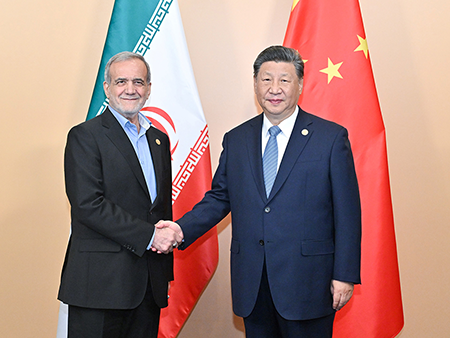
Trump can ease sanctions on Iran through executive orders and nonenforcement. In the immediate term, given the president-elect’s economic tensions with China, one attractive proposition could be to permit the sale of Iranian oil to markets other than China, with the revenues set aside for a specific use and overseen by the U.S. Department of the Treasury.
Even under U.S. sanctions, Iran exports more than 1.5 million barrels of oil per day, almost all to China.9 Iran is believed to be doing this through sanctions-busting routes operated by Iran’s Islamic Revolutionary Guard Corps and often at a steep discount to China, without ease of access to hard currency from such sales. If Iran could export oil without falling foul of U.S. sanctions, it could find potential buyers elsewhere at higher prices. Easier access to oil revenues also will be an attractive proposition for the Iranian government.
In the medium term, as part of a new nuclear deal with Iran, the United States could look to bring on board Arab partners, such as Saudi Arabia, the United Arab Emirates, and Iraq to provide economic relief to Iran. This would be a way to weave together the nuclear and regional tracks of negotiations with Tehran.
Trump instinctively wants a deal with Tehran. He has stated that he is not interested in regime change in Iran, but he wants a deal to ensure Iran does not possess nuclear weapons and is prepared to lift sanctions.10 Yet, it is evident that many will try to block any deal. Chief among them are Trump’s foreign policy advisers, some donors, and the Israeli government. All are pushing Trump to revert back to maximum pressure, arguing that this will “bankrupt” Iran and deprive it of resources to pursue its nuclear and regional goals.11
Continuing down such a confrontational path will bring Trump closer to his nightmare scenario: an Iranian nuclear bomb, an Israeli-Iranian war, and an entrenched U.S. military presence in the Middle East. If instead, Trump follows his gut instincts on dealmaking, quells Israeli opposition, and gets buy-in from the Republican majority in Congress, he can chart a new direction on policy toward Iran in ways that no other U.S. president has managed.
ENDNOTES
1. Stephanie Liechtenstein, “Iran Defies International Pressure, Increasing Its Stockpile of Near Weapons-Grade Uranium, UN Says,” Associated Press, November 19, 2024.
2. Najmeh Bozorgmehr and Bita Ghaffari, “Iran Keeps the Door Open to Talks With Donald Trump,” Financial Times, November 18, 2024; Seyed Abbas Araghchi (@araghchi), X, November 12, 2024, https://x.com/araghchi
/status/1856413334699983297.
3. Farnaz Fassihi, “Elon Musk Met With Iran’s U.N. Ambassador, Iranian Officials Say,” The New York Times, November 14, 2024.
4. The P5+1 comprises China, France, Russia, the United Kingdom, and Germany. They jointly negotiated the 2015 nuclear deal with Iran.
5. “Iran’s President Says Tehran Has to Deal With Washington,” Reuters, November 12, 2024.
6. Robin Wright, “Trump’s Close-Call Diplomacy With Iran’s President,” The New Yorker, September 30, 2019, https://www.newyorker.com/news/news-desk/donald-trumps-close-call-diplomacy-with-irans-president-hassan-rouhani.
7. “After the Deal: A New Strategy,” Heritage Foundation, May 21, 2018, https://www.heritage.org/defense/event/after-the-deal-new-iran-strategy.
8. “Trump on Sanctions,” C-SPAN, November 18, 2024, https://www.c-span.org/video/?c5142328.
9. Clayton Thomas, Liana W. Rosen, and Jennifer K. Elsea, “Iran’s Petroleum Exports to China and U.S. Sanctions,” Congressional Research Service Insight, IN12267, November 8, 2024, https://crsreports.congress.gov/product/pdf/IN/IN12267#:~:text=Iran’s%20petroleum%20exports%20reportedly%20reached,furtherance%20of%20U.S.%20foreign%20policy.
10. PDB Podcast, “Donald Trump Gets Emotional - Speaks on Tariffs, Obama and Iran,” YouTube, October 17, 2024, https://www.youtube.com/clip/UgkxkgQXjYimUvMRxutLHPy8J116KZKYDsWo; Kierra Frazier, “Trump Makes Surprising Overture to Iran at NYC Press Conference,” Politico, September 26, 2024, https://www.politico.com/news/2024/09/26/trump-iran-nyc-press-conference-00181367; “Trump on Sanctions.”
11. Felicia Schwartz and Andrew England, “Trump Team Aims to Bankrupt Iran With New ‘Maximum Pressure’ Campaign,” Financial Times, November 16, 2024.
Ellie Geranmayeh, the deputy head of the Middle East and North Africa program at the European Council on Foreign Relations, focuses on European and U.S. policies related to Iran’s nuclear program and regional activities.
December 2024
By Thomas Countryman
Donald Trump steps again into the U.S. presidency at a time when the risk of nuclear conflict remains unacceptably high, at a level not seen since the 1962 Cuban missile crisis. Amid rising geopolitical tensions, nuclear-weapon states are spending tens of billions of dollars to upgrade their arsenals; and the last remaining agreement limiting the Russian and U.S. arsenals, the world’s largest, will expire in 2026. What is the likelihood that he could reduce that risk, avoid a buildup of strategic nuclear arsenals, and reach new agreements with Moscow to maintain restraint on the Russian and U.S. strategic nuclear arsenals?
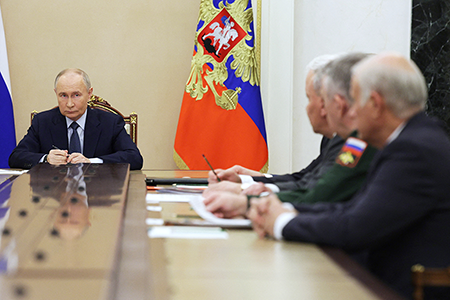
The obstacles are many, even if Trump were to place this task higher among the many dramatic changes he proposes in domestic and foreign policy. First, nuclear negotiations are linked inevitably to the Russian war in Ukraine. Russian President Vladimir Putin’s refusal to engage in any form of discussion with the United States as long as it supports Ukraine against Russian aggression remains the official Kremlin position. Even if Trump is able to force a ceasefire on the combatants, the road to a lasting solution will be long, and Putin is likely to perceive that a refusal to engage in nuclear dialogue could serve as leverage in the negotiations on Ukraine.
Second, any outcome in Ukraine that causes NATO allies to question the reliability of U.S. commitments will cause Europeans to continue to build their own defense capabilities against the possibility of renewed Russian imperialist expansion. There will be an incentive for the allies, in Asia as well as Europe, to pursue the development of their own nuclear “umbrellas,” which serves the interest of neither Moscow nor Washington.
Within the United States, the political impulse of many Republican national security leaders remains to expand rather than constrain the U.S. nuclear arsenal. Actors who are likely to have influence in the new administration already are pushing for new weapons types, a much larger nuclear weapons budget, and perhaps even the resumption of nuclear explosive testing. This trajectory is motivated more immediately by the rapid expansion of the Chinese arsenal than by Russia’s threatening behavior, but will have an effect on the nuclear balance with Moscow. It is also questionable whether U.S. negotiators, who most likely will be chosen on the basis of personal loyalty to Trump rather than on competence, will have the experience and skill necessary to reach new agreements, particularly with the New Strategic Arms Reduction Treaty (New START) expiring in fewer than 430 days.
Despite these headwinds, there remains room for very restrained optimism. Trump’s self-image as the best negotiator ever has driven his interest, going back 40 years, in negotiating nuclear issues with Moscow. His reported desire to be awarded the Nobel Peace Prize could be the incentive to prioritize reaching a breakthrough agreement with Russia, if not with Iran or North Korea. His open admiration and imitation of Putin’s strength form a basis for personal contact that has not existed under the current administration.
There are specific opportunities, short of a sweeping new treaty, that are within reach of the two presidents. Moscow and Washington need to prepare for February 5, 2026, when New START will expire and the binding limitations on deployed strategic arsenals will become history. Both states will have the capability to expand the number of their strategic deployed warheads beyond the treaty limit of 1,550, and this could happen fairly rapidly by uploading reserve warheads onto existing delivery systems.
Yet, there is no serious analysis suggesting that either side would thus enhance deterrence of the other or improve its own national security. In addition, such uploads, not to mention an unrestrained arms race reminiscent of the 1960s, would add greatly to budget and economic pressures in both countries.
Bilateral arms control has never been solely about formal treaties. Russia and its predecessor the Soviet Union and the United States significantly reduced their arsenals by less formal agreements and by reciprocal unilateral steps, particularly the presidential initiatives of the early 1990s. Putin and Trump could reach a political agreement, in brief and clear language, that each would continue to respect New START deployment limits as long as the other side did the same. Trump could even begin the process and gain the praise that would come with it by making this a unilateral statement and inviting Putin to join him.
The two biggest nuclear powers also need to find a way to discuss all elements that bind them together in nuclear danger. It is more than unfortunate that the bilateral strategic stability dialogue ended after the full-scale Russian invasion of Ukraine in February 2022, first suspended by the U.S. side then jettisoned entirely by Moscow. Even U.S. President Joe Biden’s offer of less formal “discussions” on a new nuclear arms control framework have been taken by Russia as a sign of U.S. eagerness and therefore something to be leveraged.
It should be possible to restart contacts among nuclear experts and decision-makers on both sides. To make clear that this is a fresh start, there should be no return to the grand title of strategic stability dialogue. In addition, Moscow would have to climb down from its insistence that the agenda is to formulate a new “strategic equation” that covers every conceivable security issue. That would leave a lot of room for the two sides to begin a discussion that does not exclude any topic of importance to either one. It is less important to have high-level, high-visibility events than to begin and sustain regular discussions at middle levels.
Such a discussion could uncover other areas of potential agreement. One that was too readily dismissed in the past is the possibility of addressing the risk of escalation following the collapse of the Intermediate-Range Nuclear Forces Treaty. Something short of a treaty could reduce the risk and expense of a new missile race in Europe and Asia. The two sides also need to address urgently the new challenge posed by the reported Russian deployment of weapons in outer space and find a way to avoid a new arms race in this dimension.
The world witnessed a dramatic reduction in the risk of nuclear war between 1962 and 2014 as a series of leaders in Moscow and Washington took bold steps to protect the security of their people. U.S. leadership and initiative and the courage to put creative proposals on the table were key to this success at every stage. This moment demands no less. Trump’s foreign policy legacy will depend in great measure on his readiness not just to put forward meaningful ideas, but to see them through to completed agreements.
Thomas Countryman, a retired U.S. diplomat, is chairman of the board of the Arms Control Association.
Ukraine fired U.S.-supplied missiles deeper into Russia after the United States authorized such attacks.
December 2024
By Xiaodon Liang
Ukraine conducted a missile strike Nov. 19 on an armament depot in the Bryansk region of Russia using what Ukrainian and U.S. media described as U.S.-supplied short-range ballistic missiles. The strike took place days after the United States authorized such attacks following months of pressure from Ukraine.
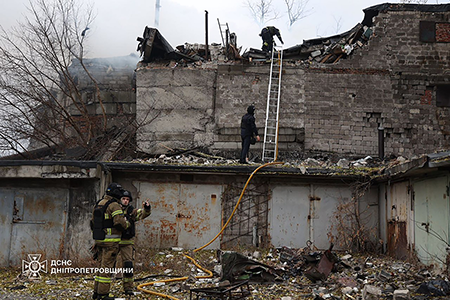
Russia responded two days later by launching a previously unknown intermediate-range ballistic missile at the Ukrainian city of Dnipro as part of a large-scale missile attack. The new missile, called the Oreshnik in televised comments by Russian President Vladimir Putin on Nov. 21, was targeted at facilities that historically have been involved in Ukrainian missile production.
Reuters, The New York Times, The Washington Post, and other media outlets reported on Nov. 17 that they were briefed by unnamed U.S. officials that the Biden administration had lifted its policy barring Ukraine from using U.S.-origin missiles to strike targets far behind the frontlines of the Russian invasion. (See ACT, October 2024.)
Ukrainian President Volodymyr Zelenskyy referred to but did not confirm the decision in a Nov. 17 address. “[S]trikes are not carried out with words. Such things are not announced. Missiles will speak for themselves,” he said.
The United States has provided Ukraine with the Army Tactical Missile System (ATACMS), a short-range ballistic missile with a range of roughly 300 kilometers. These missiles were first used in attacks against Russian forces within occupied Ukraine last year. (See ACT, November 2023.)
But the first use of these weapons against targets in Russia came in the morning of Nov. 19, when the Ukrainian military confirmed it had attacked an armaments depot in the city of Karachev in Bryansk. RBC Ukraine and The New York Times, citing unnamed Ukrainian and U.S. military sources, reported that the strike was conducted using ATACMS.
The same depot was the target of a Ukrainian drone strike in early October. U.S. officials have said that permitting attacks with U.S.-origin weapons systems would not affect the military balance of the war because Ukrainian drones were already capable of reaching Russian targets far behind the frontlines. (See ACT, October 2024.)
The Russian Ministry of Defence said Nov. 26 that Ukraine had conducted additional ATACMS strikes against an airfield and air defense site in the Russian territory of Kursk, Reuters reported.
Ukraine also fired UK-supplied Storm Shadow cruise missiles at targets in Russia for the first time, the BBC reported on Nov. 20. Because these missiles contain U.S.-origin components, they also were subject to the restrictions of the now-lifted U.S. policy.
Official confirmation of the U.S. policy shift came a week after initial reports, when John Kirby, White House national security communications adviser, said in a Nov. 25 press briefing that “we did change the guidance and gave them guidance that they could use them.”
According to media reports, the shift in the Biden administration’s policy was prompted by the arrival of North Korean troops in support of the Russian invasion. The United States believes that about 11,000 North Korean troops are serving in Kursk, where Ukrainian forces have pushed across the international border, according to Nov. 18 comments by a U.S. Defense Department spokesperson.
The decision to permit strikes with U.S.-origin weapons “is reckless, dangerous, aimed at a qualitative change, a qualitative increase in the level of involvement of the United States in this conflict,” Russian presidential spokesperson Dmitry Peskov said Nov. 18, according to Reuters.
Following the strike involving the new Russian intermediate-range missile, Peskov told journalists that “[t]he main message is that the reckless decisions and actions of Western countries that produce missiles, supply them to Ukraine, and subsequently participate in strikes on Russian territory cannot remain without a reaction from the Russian side,” Reuters reported.
A U.S. Defense Department spokesperson said on Nov. 21 that the Oreshnik is an intermediate-range missile derived from the RS-26 intercontinental ballistic missile (ICBM), although Russia has described the new weapon as a “medium-range” missile. The Oreshnik had six warheads, according to a Ukrainian military intelligence press release on Nov. 22.
The RS-26 is classified as an ICBM because it was tested to a range of more than 5,500 kilometers. But during development, Russia also tested the missile at intermediate ranges, raising questions about whether it challenged the spirit of the now-defunct Intermediate-Range Nuclear Forces Treaty. Because these tests did not create a violation of the letter of the treaty, the RS-26 was not central to U.S. allegations of Russian noncompliance. (See ACT, April 2014.)
December 2024
By Tong Zhao
Following President Donald Trump’s reelection, China anticipates a more confrontational U.S. policy and is bracing for intensified strategic competition. Beijing is likely to double down on bolstering its nuclear arsenal, emphasizing the Chinese military Rocket Force mission of “strategic counterbalance,” the use of strategic military capabilities to moderate adversaries’ broader approaches toward China.
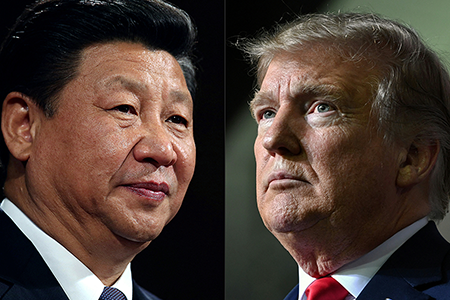
During Trump’s first term, the Chinese leadership came to view the United States as an existential threat, not primarily due to changes in U.S. nuclear policy but because of a severe deterioration in bilateral relations broadly. This has driven Beijing to rely increasingly on the perceived coercive power of nuclear weapons to stabilize its overall relationship with Washington. In Trump’s second term, non-nuclear tensions may escalate further through systematic economic decoupling and heightened geopolitical confrontation.
In the nuclear domain, U.S. patience with China is wearing thin. Beijing’s unwillingness to explain or constrain its nuclear buildup has prompted Washington to consider significant enhancements to U.S. nuclear capabilities. Owing to its deep-rooted siege mentality, China likely will interpret these measures as further evidence of U.S. “hegemonic” ambitions rather than responses to its own actions. Beijing may become more convinced that Washington is actively pursuing a disarming first-strike capability.
The second Trump presidency likely will revive strict visa and security measures, thus constraining personnel exchanges between the two countries. The resulting decline in dialogue between nuclear policy experts could lead both sides to embrace more pessimistic interpretations of each other’s nuclear capabilities, goals, and strategic designs.
Compounding the challenges, Washington’s internal policy environment under the new administration is likely to be highly polarized. Fierce clashes between “pro-deterrence” and “pro-arms control” advocates could lead to intense criticism of many of the administration’s nuclear policy decisions. This internal discord could lead Beijing to view the U.S. political landscape as too unstable for meaningful long-term engagement and thus further entrench its resistance to engaging in substantive strategic dialogue with Washington. Paradoxically, fierce domestic opposition to Trump’s nuclear policies also might amplify unintentionally China’s internal narrative, which fixates on U.S. policy flaws, making Beijing even less likely to recognize its share of responsibility for rising tensions.
The next four years mark a critical juncture in the nuclear paths of both nations. As the Trump administration sets the direction of U.S. nuclear enhancement, China also enters a critical phase of its own nuclear development. Having restructured the Rocket Force leadership, Chinese President Xi Jinping now emphasizes “strengthening targeted training with new equipment, skills, and combat methods.”1 In the coming years, the Rocket Force likely will prioritize developing operational doctrines that define how to employ its expanded capabilities. This process will determine whether and to what extent the leadership’s focus on “combat capabilities” evolves into a more pronounced war-fighting doctrine for its nuclear forces.
A particularly volatile issue lies in the two countries’ approaches to theater-range nuclear forces. Potential U.S. efforts to increase the number of warheads on intercontinental delivery systems may draw attention, but it is the possibility that the United States might deploy tactical nuclear weapons in the Asia-Pacific region that raises greater alarm in China. The second Trump presidency overlaps with Xi’s reported timeline for developing sufficient military capabilities to overtake Taiwan. As the U.S. and Chinese militaries intensify preparations for a Taiwan contingency, they also are conducting increasingly detailed planning for nuclear deterrence in regional conflicts. Each side seeks the ability to manage nuclear escalation if deterrence fails, attempting to prevent unlimited nuclear exchange while securing advantageous terms for ending the conflict.
Once started, competition in escalation management propels rivals into a destabilizing spiral of increasingly diverse and expanding nuclear arsenals. The scarcity of authoritative information about operational military planning on both sides fuels excessive threat perception. It is also difficult to prevent competition that begins at lower rungs of the escalation ladder from expanding upward to higher levels, further increasing the likelihood of a full-scale arms race.
Failure to appreciate action-reaction dynamics heightens these risks. China has assumed mistakenly that its nuclear expansion, including its massive development of increasingly accurate theater-range nuclear-capable missiles, would not provoke responses from other powers. Many U.S. experts also downplay the likelihood that U.S. efforts to enhance low-yield nuclear weapons and forward-deployment capabilities will intensify China’s threat perception and trigger additional countermeasures.
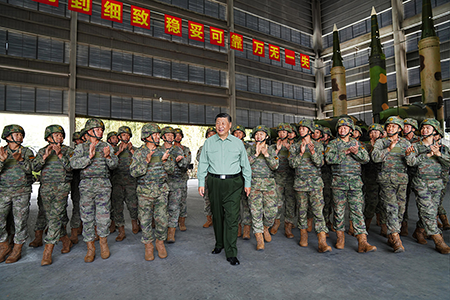
The Trump administration appears prepared to advocate for the expansion of tactical nuclear capabilities, believing that perceived weaknesses in this area could embolden China to consider nuclear first use in a regional conflict. Yet, there is no evidence in Chinese writings or analysis that the Chinese military perceives such weaknesses in U.S. nuclear capabilities. On the contrary, Chinese military analysts are focused predominantly on what they see as a growing U.S. interest in lowering the nuclear threshold and preparing for limited nuclear wars. This perception in turn has driven China’s investments in limited nuclear retaliation and escalation management capabilities.
Likely destabilizing the situation further is the erosion of the global nonproliferation regime. Trump’s anticipated rollback of U.S. security commitments to allies and partners has sparked concerns that countries such as South Korea might pursue nuclear weapons technology. Some U.S. experts are suggesting that Ukraine consider developing its own nuclear weapons option if it cannot secure adequate external security guarantees such as NATO membership. Any shift toward tacitly endorsing such “friendly proliferation” would dismantle decades of nonproliferation norms and remove crucial guardrails in Chinese-U.S. competition. Beijing might interpret this as confirmation that foundational international norms have lost their relevance.
In this climate, convincing China that the Australian-UK-U.S. nuclear submarine program is not a pathway to Australian nuclear weapons development would be much more difficult. It also would be difficult to foresee how Beijing might recalibrate its stance on nuclear nonproliferation in response. Before introducing radical changes with unpredictable consequences, Trump should engage Xi directly on two key issues: initiating serious arms control discussions and addressing how China’s passivity toward Russian aggression and North Korean provocations fuel nuclear proliferation, ultimately undermining China’s own strategic interests.
Confronted with unprecedented risks of nuclear arms races and proliferation, Chinese and U.S. nuclear policy experts carry a historic responsibility to assess critically their respective leaders’ policy choices.
Thoughtful debate on the long-term consequences of their own country’s policies, coupled with a nuanced understanding of their rival’s perspective, is essential to avoiding the catastrophic outcomes of strategic miscalculations.
ENDNOTES
1. “Xi Urges Strategic Missile Troops to Enhance Deterrence, Combat Capabilities,” Xinhua
News Agency, October 19, 2024, https://english.www.gov.cn/news/202410/19/content_WS67136968c6d0868f4e8ec184.html.
Tong Zhao is a senior fellow at the Carnegie Endowment for International Peace, working for the Nuclear Policy Program and Carnegie China.
U.S. President Joe Biden’s decision contradicts his administration's own policy barring such transfers.
December 2024
By Doniyor Mutalov
U.S. President Joe Biden approved plans to supply Ukraine with anti-personnel landmines, changing his administration’s policy barring such transfers and violating the global norm against their use.
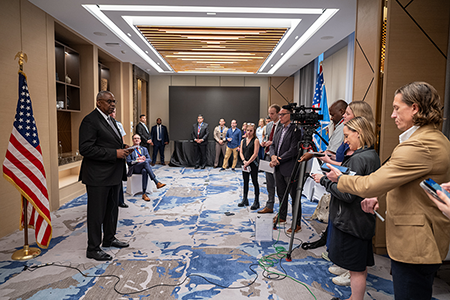
U.S. officials argue that landmines would bolster Ukrainian defenses against Russia’s full-scale invasion. The Ukrainians “have a need for things that can help slow down that effort on the part of the Russians,” Defense Secretary Lloyd Austin told a press briefing on Nov. 20 while traveling in Laos. Austin attempted to address concerns about the humanitarian impact of the landmines by asserting that the United States will provide nonpersistent anti-personnel landmines that are designed to self-destruct.
In a briefing on Nov. 22 at the White House, senior officials said the decision was designed to thwart Russia's increasing reliance on infantry to attack Ukrainian defensive positions.
The decision to supply landmines to Ukraine is a change to U.S. policy adopted in 2022 that prohibits any transfer or export of U.S. landmines and bars their use anywhere except the Korean peninsula. (See ACT, July/August 2022.) The policy also indicated the intention of the United States to “undertake diligent efforts to pursue materiel and operational solutions to assist in becoming compliant with and ultimately acceding to the Ottawa Convention.” The 2022 policy restricted the broader use of landmines permitted by the Trump administration in 2020. At the time, Biden described the Trump administration’s stance on landmines as “reckless.”
The 1997 Ottawa Convention, also known as the Mine Ban Treaty, outlaws the production, use, stockpiling, and transfer of anti-personnel landmines worldwide. As of November, there are 164 states-parties to the treaty, representing more than 80 percent of the world’s states. Ukraine ratified the treaty in 2005, but Russia and the United States are not signatories.
Russia’s relentless use of landmines in the war has already made the conflict zone in Ukraine one of the most heavily mined areas in the world, and the supply of landmines by the United States will very likely exacerbate the contamination.
By acquiring or using anti-personnel landmines, Ukraine will violate its obligations under the Mine Ban Treaty. Ukraine cannot withdraw from the treaty before acquiring landmines because the treaty bars withdrawal if a state-party is engaged in armed conflict. A decision to withdraw would only enter into effect after the end of the Russian war against Ukraine.
The fifth review conference of the Mine Ban Treaty will take place in Cambodia Nov. 25-29 and will be attended by representatives of the United States and Ukraine.
The document outlines a wider range of contingencies that might trigger nuclear weapons use and appears to lower the threshold for nuclear use.
December 2024
By Daryl G. Kimball
The Kremlin announced on Nov. 19 that Russian President Vladimir Putin signed a decree updating the government’s formal policy on the possible use of nuclear weapons. The document outlines a wider range of contingencies that might trigger nuclear weapons use, especially in regard to non-nuclear weapons threats to Russia and its allies, and appears to lower the threshold for nuclear use.
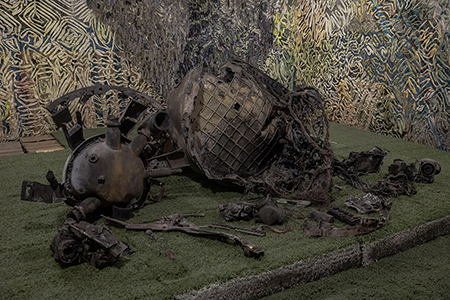
The update of Russia’s nuclear doctrine was previewed by Putin in comments delivered on Sept. 25. (See ACT, November 2024.) It was issued just days after it was reported that U.S. President Joe Biden had decided to authorize Ukraine’s use of U.S.-supplied long-range missiles to strike targets deeper into Russia as a means of thwarting ongoing Russian attacks on Ukrainian territory. Russia had warned that such a U.S. move would change the nature of the conflict.
The revised nuclear doctrine includes language asserting that Russia “reserves the right” to use nuclear weapons not only in response to a nuclear attack, but also to respond to a conventional weapons attack that creates a “critical threat” to its “sovereignty and territorial integrity” or to that of Russia’s ally, Belarus. The previous version of Russia’s nuclear weapons doctrine, issued in 2020, reserves the right to use nuclear weapons if an attack on Russia threatens “the very existence of the state.”
The new document, titled “Fundamentals of the State Policy of the Russian Federation in the Field of Nuclear Deterrence,” states that Russia considers “nuclear weapons as a means of deterrence, the use of which is an extreme and necessary measure, and is making all necessary efforts to reduce the nuclear threat and prevent the aggravation of interstate relations that could provoke military conflicts, including nuclear conflicts.”
The revised policy also states that Russia may use nuclear weapons in the event there is “reliable information on the launch of ballistic missiles attacking the territories of the Russian Federation and/or its allies” or “the use by the enemy of nuclear or other types of weapons of mass destruction on the territory of the Russian Federation and/or its allies, on military formations and/or facilities of the Russian Federation located outside its territory.”
It says that Russia may use nuclear weapons in the event of “aggression against the Russian Federation and/or the Republic of Belarus…with the use of conventional weapons, creating a critical threat to their sovereignty and/or territorial integrity.” Another scenario involves a response to the “receipt of reliable information on the massive launch (take-off) of aerospace attack weapons (strategic and tactical aircraft, cruise missiles, unmanned, hypersonic and other aircraft) and their crossing of the state border of the Russian Federation.”
In contrast, the Biden administration’s 2022 Nuclear Posture Review asserts that the “fundamental purpose” of U.S. nuclear weapons is to deter nuclear attack and that nuclear weapons use would be reserved for “extreme circumstances to defend the vital interests of the United States or its allies and partners.”
The IAEA Board of Governors censured Iran for failing to cooperate with the agency, despite Tehran signaling it would freeze its stockpile of uranium enriched to near-weapons grade levels.
December 2024
By Kelsey Davenport
The International Atomic Energy Agency (IAEA) Board of Governors censured Iran for failing to cooperate with the agency, despite Tehran signaling it would freeze its stockpile of uranium enriched to near-weapons-grade levels.

The censure was introduced by France, Germany, the United Kingdom, and the United States after IAEA Director-General Rafael Mariano Grossi reported that Iran did not provide any information to resolve a years-long investigation into the presence of undeclared nuclear materials at two sites that are not part of the country’s nuclear program.
Grossi did report that the agency verified on Nov. 16 that the Atomic Energy Organization of Iran (AEOI) took initial steps to halt the accumulation of uranium enriched to 60 percent U-235, a level just shy of the 90 percent U-235 considered weapons-grade.
Grossi said during a Nov. 20 press conference that he proposed that Tehran take this step during a Nov. 14-15 trip to Iran.
He also observed an “intense disposition” for engagement by Iranian officials during his trip, which included meetings with Iranian President Masoud Pezeshkian and Foreign Minister Abbas Araghchi.
Although Grossi described Iran’s commitments during the trip as “important,” the progress was not enough to prevent the Europeans and the United States from moving forward with the resolution, which passed Nov. 21 by a vote of 19-3, with 12 abstentions. The censure marks the fourth time that the board has used a resolution to push Iran to provide the agency with technically credible explanations for uranium detected at undeclared locations in 2020 and 2021. (See ACT, July/August 2024.)
Similar to the previous three resolutions, Russia and China opposed the measure.
Prior to the vote, Iranian Deputy Foreign Minister Kazem Gharib Abadi told journalists that Iran would “respond decisively and immediately” to a resolution. Following the vote, the Iranian Foreign Ministry and the AEOI issued a statement ordering the “activation” of “various types” of advanced centrifuges.
The statement did not provide specifics, but a IAEA report on Nov. 19 regarding Iran’s nuclear program noted that Iran has IR-2 centrifuges at its Natanz uranium-enrichment facility and IR-6 centrifuges at its Fordow uranium-enrichment facility that are not currently operating. The IR-2 and IR-6 centrifuges enrich uranium more efficiently. The AEOI order to “activate” additional centrifuges likely referred to introducing uranium into those machines.
The statement did not mention if Iran would reverse its commitment to halt the accumulation of uranium enriched to 60 percent U-235.
Grossi told reporters that there was “no conditionality” regarding the proposal on 60 percent U-235 enrichment, but Iranian officials suggested that the country would reverse the decision if the board passed the censure.
The Europeans and the United States consistently have raised concerns about Iran’s enrichment of uranium to 60 percent U-235, given how quickly the material can be enriched to weapons grade. But it is not mentioned in the resolution, which focuses on safeguards issues.
In the Nov. 21 resolution, the board “reaffirms its decision that it is essential and urgent” for Iran to provide “technically credible explanations” for the presence of uranium at Varamin and Turquzabad.
During his trip, Grossi discussed “possible elements” to resolve the agency’s questions about undeclared nuclear materials detected at Varamin, a site where the IAEA assesses that Iran undertook uranium-milling and -conversion activities that were not declared to the agency. The IAEA “will continue to work with Iran towards making substantive progress” on this issue, the Nov. 19 report said.
The Europeans and the United States did not view the discussions as tangible progress. In a Nov. 21 joint statement, they said that there has been “no progress” on the safeguards investigation since June. The statement noted that the resolution passed by the board in June said that Tehran needed to provide “full and unambiguous cooperation with the agency to resolve all outstanding safeguards issues” or face further action.
The Nov. 2 resolution also requests that Grossi provide a “comprehensive and updated assessment” regarding the undeclared nuclear materials in connection with “past and present outstanding issues regarding Iran’s nuclear program” by March 2025.
Grossi has suggested that such a report is not necessary. During the board meeting in September, he said at a press conference that the IAEA already has provided an assessment of what occurred at the sites where undeclared uranium was detected. (See ACT, October 2024.)
The Europeans and the United States said that the requested comprehensive report will allow the board to “consider whether further steps are needed.”
Iran, joined by eight other states including China and Russia, said in a Nov. 21 statement that the resolution demonstrated an “unconstructive and confrontational approach” and “undermines ongoing” engagement.
The board’s priority should be to “strongly encourage and support” engagement between the IAEA and Iran, the statement said.
After the resolution passed, the Europeans and the United States welcomed the vote and expressed hope that Iran will “take the opportunity” to resolve the outstanding issues before the comprehensive report is completed so that the board can “close consideration” of the matter.
Despite the contentious meeting, Iranian officials and representatives of the three European countries met in Geneva on Nov. 29 to discuss a range of issues, including Iran’s nuclear program. The United States did not participate in the talks, but that could change after U.S. President-elect Donald Trump takes office in January. During his campaign, Trump said the United States “has to make a deal” with Iran.
Despite Trump’s withdrawal from the 2015 nuclear deal in May 2018, Pezeshkian suggested on Nov. 12 that Iran is willing to engage the Trump administration. Iran will “have to deal” with the United States, and it is better for Tehran to “handle the relationship,” he said.
Pezeshkian’s support for nuclear diplomacy comes amid continued calls by high-level Israeli officials to strike Iran’s nuclear program.
Israeli Defense Minister Israel Katz said on Nov. 11 that Iran is “more exposed than ever to damage to its nuclear facilities” and that Israel has the chance to “remove the threat” posed by the nuclear program.
The Biden administration signaled that it will not restrict U.S. arms transfers despite Israel’s failure to permit increased humanitarian aid to Gaza as top U.S. officials had demanded.
December 2024
By Michael T. Klare
The Biden administration signaled that it will not restrict U.S. arms transfers to Israel despite that country’s failure to permit increased deliveries of humanitarian aid to Gaza as top U.S. officials had demanded.

Although the situation in Gaza “is a very dire circumstance,” there will be no reduction in U.S. arms assistance to Israel, State Department spokesperson Vedant Patel told a news briefing on Nov. 12.
But the United States will continue to press the Israelis to expedite the flow of humanitarian aid to the embattled enclave, Patel indicated. “[W]hat we need to see is we need to see these steps acted on,” he said. “We need to see them implemented.”
In a letter to senior Israeli officials on Oct. 14, U.S. Secretary of State Antony Blinken and Defense Secretary Lloyd Austin complained of the sharply deteriorating humanitarian situation in Gaza, where Israel has conducted a fierce retaliation since the Oct. 7, 2023, raid in which Hamas killed 1,200 people and took 250 hostage.
According to the letter, Israel had imposed severe restrictions on aid flows to Gaza, resulting in a 50 percent decline in deliveries over the preceding six months, drastically reducing food and medical supplies to the Palestinian civilian population.
To be assured of receiving U.S. military assistance, Israel would have to take immediate steps to eliminate those restrictions and allow more aid to reach Gaza, the letter said.
“To reverse the downward humanitarian trajectory [in Gaza] as consistent with its assurances to us, Israel must, starting now and within 30 days act on [a number of] concrete measures,” such as opening additional border crossings and lifting restrictions on aid convoys from southern to northern Gaza, Blinken and Austin wrote. A failure to do so, they indicated, could result in diminished U.S. arms aid to Israel as required by law.
Section 620I of the Foreign Assistance Act states that, “No assistance shall be furnished under this Act or the Arms Export Control Act to any country when it is made known to the President that the government of such country prohibits or otherwise restricts, directly or indirectly, the transport or delivery of United States humanitarian assistance.” The president can waive this restriction if he determines that doing so would be in the national interest.
Any significant reduction in U.S. arms transfers to Israel, if sustained for any length of time, would have serious consequences for that country. According to the Stockholm International Peace Research Institute, the United States is Israel’s leading arms supplier, accounting for 69 percent of its arms imports in 2023. These include many of the weapons used by the Israelis in their war against Hamas and Hezbollah.
Despite this dependency, Israel made no visible effort to comply with the requirements in the Blinken-Austin letter. Among the demands was a requirement for daily entry into Gaza of 350 trucks carrying humanitarian aid. In late October, an average of only 58 trucks were reported to be making the crossing.
A group of scientists from the UN-affiliated Famine Review Committee said on Nov. 8 that, with food supplies rapidly diminishing, “starvation, malnutrition, and excess mortality due to malnutrition and disease are rapidly increasing” and that a deadly famine was “imminent.”
Sen. Bernie Sanders (I-Vt.), a vocal critic of Israeli tactics in its war against Hamas and of the Biden administration’s military support for Israel despite serious human rights concerns, proposed three resolutions to block continued arms transfers, but they were soundly defeated by the Senate on Nov. 20. Nevertheless, 17 Senate Democrats and two independents voted for at least one of the measures, a sign of growing party divisions over Israel’s handling of the war, now entering its 14th month.
Meanwhile, on Nov. 18, Politico reported that 20 White House staff members had written a letter to their superiors calling on President Joe Biden to follow through with the threat to close the arms spigot.
U.S. President Joe Biden also reiterated that a human should always remain “in the loop” for decisions on nuclear weapons use.
December 2024
By Xiaodon Liang
As he prepares to leave office, U.S. President Joe Biden issued a policy memorandum on the use of artificial intelligence (AI) for national security purposes and reiterated his administration’s stance that a human should always remain “in the loop” for informing and executing decisions on nuclear weapons use.
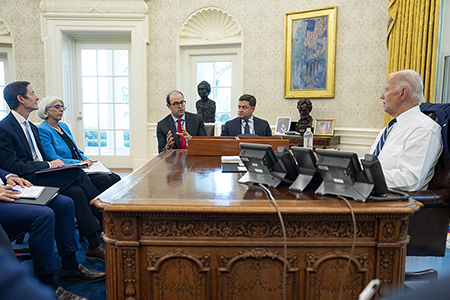
The national security memorandum, published Oct. 24, addresses not only the use of AI by executive branch agencies involved in national security, but also expands on the outgoing administration’s policy of promoting U.S. research into leading-edge AI models.
“We have to be faster in deploying AI in our national security enterprise than America’s rivals are in theirs. They are in a persistent quest to leapfrog our military and intelligence capabilities,” National Security Advisor Jake Sullivan said in a speech introducing the memorandum at the National Defense University.
The memorandum sets forth immigration, energy, resource-sharing, and rules-setting policies and practices designed to promote U.S. leadership in what the Biden administration calls “safe, secure, and trustworthy AI.”
The memorandum, prepared by the National Security Council and signed by Biden, calls for the publication of a subsidiary document, titled “Framework to Advance AI Governance and Risk Management in National Security” by the council’s deputies committee. A first version of this framework was released concurrently with the memorandum.
The framework creates three regulated categories of cases for AI use: prohibited, high impact, and those affecting federal personnel. Agencies will be required to adopt minimum risk management practices for high-impact and federal personnel-impacting cases or seek an annual waiver to avoid this requirement when it would “increase risks to privacy, civil liberties, or safety, or would create an unacceptable impediment to critical agency operations or exceptionally grave damage to national security.”
“The policy imposes few substantive safeguards on a wide range of AI-driven activities, by and large allowing agencies to decide for themselves how to mitigate the risks posed by national security systems,” the American Civil Liberties Union warned in an Oct. 24 press release. Patrick Toomey, deputy director of the advocacy organization’s National Security Project, criticized the Biden administration’s approach for lacking “transparency, independent oversight, and built-in mechanisms for individuals to obtain accountability.”
Waivers will not be available for prohibited cases of AI use. The list of prohibitions includes violations of certain civil liberties, as well as a general ban on using AI to “[r]emove a human ‘in the loop’ for actions critical to informing and executing decisions by the President to initiate or terminate nuclear weapons employment.”
The framework requires that oversight and “rigorous testing and assurance” accompany the use of AI in determining collateral damage and estimating casualties before kinetic actions. Intelligence analysis and reports based “solely” on AI outputs also are permitted as long as the reader is provided with sufficient warning.
The Commerce Department will play a significant role through its AI Safety Institute in assessing the national security risks of leading-edge AI models. The institute will serve as the “primary port of call for U.S. AI developers,” according to an unnamed senior administration official speaking to journalists on Oct. 24 regarding the memorandum.
The memorandum also addresses the nonproliferation implications of AI by instructing the National Nuclear Security Administration to develop within 120 days, in partnership with the AI Safety Institute and the National Security Agency, “the capability to perform rapid systematic testing of AI models’ capacity to generate or exacerbate nuclear and radiological risks.”
By empowering and creating an AI risk assessment structure within the government, the White House hopes to accelerate AI research by making clear the rules of the road. “Ensuring security and trustworthiness will actually enable us to move faster, not slow us down. Put simply, uncertainty breeds caution,” Sullivan said in his speech.
“We know that China is building its own technological ecosystem with digital infrastructure that won’t protect sensitive data, that can enable mass surveillance and censorship, that can spread misinformation, and that can make countries vulnerable to coercion,” Sullivan said. Nonetheless, the United States should be “willing to engage in dialogue about this technology with [Beijing] and with others to better understand risks and counter misperceptions,” he said.
Biden and Chinese President Xi Jinping renewed their commitment to the human-in-the-loop principle during a Nov. 16 meeting on the sidelines of the Asia-Pacific Economic Cooperation summit in Lima, according to Bloomberg.
During the U.S. presidential campaign, the Republican Party adopted a policy platform calling for the revocation of Executive Order 14110, which laid out in October 2023 the Biden administration’s AI policies and preceded the publication of the recent national security memorandum. Instead, the platform promised to “support AI Development rooted in Free Speech and Human Flourishing.”
Some parts of the Biden framework may survive a partisan transition in the White House. The AI Safety Institute has bipartisan support, and bills granting it a basis in law have passed out of House and Senate committees.
